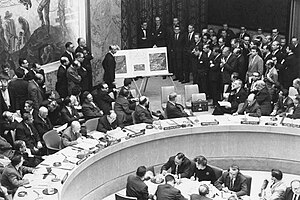World history/WHME103/Developing world/Overview
During the Cold War, many nations aligned themselves with either the United States or the Soviet Union. Each superpower sought power and influence across the globe, in an attempt to gain political and military advantage over the other. The United States and the Soviet Union never went to war directly, but there were a number of proxy wars and conflicts, many in developing nations. In the post-war period, the decline of European colonial powers and growing nationalism contributed to the decolonization process. Many former colonies in Africa and Asia gained independence in the 1950s and 1960s. Some chose to chart a course that avoided alignment with either capitalist or communist ideologies and powers, becoming part of the growing Non-Aligned Movement.
During this learning pathway you will watch/listen to two video lectures, complete three readings and examine one primary source document.
